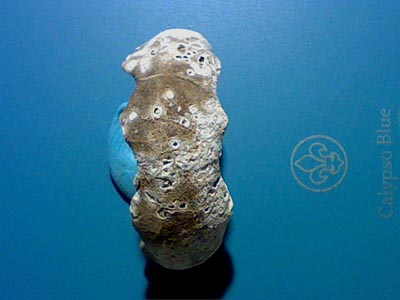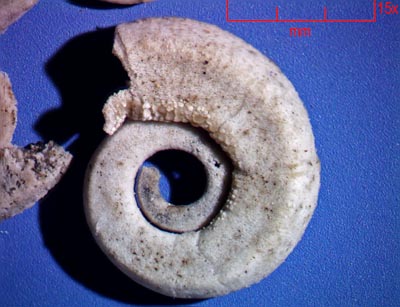|
This is the
only planispiral gastropod to be had in any quantity in the Fort
Apache Limestone. The size range of specimens is huge, ranging
from pinhead size microscopic juveniles up to six inch monsters
found impressed in the limestones. And to add as a bonus - two
species are found here in this formation. Straparollus gastropods
are unusual in that they have a nearly square cross section of
their tubes, and are quite flat on the sides as well. While most
Straparollus are rimmed with a linear continuous rib on the outer
coils, Straparollus Kaibabensis is nearly unique in that it has
nodes or tubercles along its coils instead. This makes it appear
at first glance to be a nautiloid, however without any septa
or the pear shape opening cephalopods have, they are simply huge
gastropods. Winters found both types as well in his GSA Memoir
89 from outcrops all on the Fort Apache Indian reservation.
Our finds include
many silicified specimens, most partials, and several limestone
impressions as molds. Also, they can be very small indeed, the
smallest members are best seen in the microscope at 30x magnification.
This contrasts with the monstrous specimen we found back in 2006
that was over six inches in diameter!
Straparollus
(Euomphalus) Kaibabensis - Quick Cam shots

|
The
outer 2 or 3 whorls is where the nodes develop in mature specimens.
This partial outer arc shows them very well. The entire outside
rim of the shell is wider as a result of these ornaments. |

|
Strongly
low angle top lit, this shows the nodes well. Same specimen. |

|
Dorsal
view of the same conch, which you can see the swelling of the
width for every node present. This also gives it a very nautiloid
like appearance. |

|
Inside
view shows the double wall that is characteristic of Straparollus.
This is another feature that differentiates it from nautiloids
in the field. |

|
On
this one the outer whorls still easily shows the nodes in this
low light shot. This specimen was left attached to the limestone
on the lower right as to give it a handle to more easily position
the specimen. |

|
Top
view of same specimen, showing nodal swellings. |

|
Inside
view - No septa to be found here! The wall thickness is amazing. |

|
Other
side view same specimen. |
Straparollus
(Euomphalus) Kaibabensis - Digicam Shot

|
This
big fella was found back in 2006 on an expedition with some museum
members on an exploratory hike. I hauled this one back in my
back pack over 2 miles to the truck. Its preservation is poor,
but you can easily see the nodes. A modeling clay cast was made
of this one to show it as a positive cast below. |
 |
Modeling
clay cast of above to show positive relief. The nodes are easy
to see and the curvature of the conch is evident. This took 4.5
pounds in clay to do... |
 |
Another
limestone impression of a smaller specimen. We practiced our
clay molding on this one to test the technique. Talcum powder
was used as a mold release, since the clay was white anyway.
Worked really well! |
Straparollus
(Euomphalus) sp. - Microscope shots

|
Juveniles
all together at 7x. The one at the lower left shows the protoconch,
and others already shows the linear ribbing of Straparollus sp.
Note also in the juveniles, sometimes the coils don't touch.
This is a defining character of Straparollus. |

|
A
gorgeous miniature Straparollus! You can see the coils have gaps
between them here as well. The ridges and nodes have not developed
yet. |

|
This
juvenile is starting to show the beginnings of the linear ribbing.
It will grow very fast. |

|
This
one was just nice to show the inner coils and protoconch well,
and a section of the outer whorls forming the square profile
with linear ribbing. It is still to early to tell if it will
have nodes. |

|
A
beautiful specimen already showing its linear ribbing. Its pretty
big at this point, about 1 cm in size. Notice how the rib fades
in height as it nears the center. |

|
Some
non ornamented outer whorls of a regular Straparollus sp. |
Straparollus
(Euomphalus) sp. - Quick Cam Shots

|
While
a bit distorted from compression of overlying sediments, this
complete specimen shows the linear ridges well and detail all
the way into the protoconch. I left it in the limestone along
with some beautiful cone shaped gastropods for a composite view
of the sea bottom. It almost looks as if its sitting in the bottom
muds. |

|
Closer
view of above specimen. It would probably have fallen apart if
I had continued to acid etch the limestone, so I stopped. |

|
Growth
lines in one of the middle whorls, as an internal cast. |

|
The
double shell structure of Straparollus is well seen here in this
end on view which is the above specimen. This would have been
to strengthen the huge conch as is grew to larger sizes. |
|


